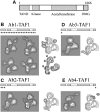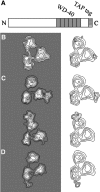Mapping key functional sites within yeast TFIID
- PMID: 14765106
- PMCID: PMC381015
- DOI: 10.1038/sj.emboj.7600111
Mapping key functional sites within yeast TFIID
Abstract
The transcription factor TFIID, composed of the TATA box-binding protein (TBP) and 14 TBP-associated factors (TAFs), plays a key role in the regulation of gene expression by RNA polymerase II. The structure of yeast TFIID, as determined by electron microscopy and digital image analysis, is formed by three lobes, labelled A-C, connected by thin linking domains. Immunomapping revealed that TFIID contains two copies of the WD-40 repeat-containing TAF5 and that TAF5 contributes to the linkers since its C- and N-termini were found in different lobes. This property was confirmed by the finding that a recombinant complex containing TAF5 complexed with six histone fold containing TAFs was able to form a trilobed structure. Moreover, the N-terminal domain of TAF1 was mapped in lobe C, whereas the histone acetyltransferase domain resides in lobe A along with TAF7. TBP was found in the linker domain between lobes A and C in a way that the N-terminal 100 residues of TAF1 are spanned over it. The implications of these data with regard to TFIID function are discussed.
Figures






Similar articles
-
Architecture of TAF11/TAF13/TBP complex suggests novel regulation properties of general transcription factor TFIID.Elife. 2017 Nov 7;6:e30395. doi: 10.7554/eLife.30395. Elife. 2017. PMID: 29111974 Free PMC article.
-
Crystal structure, biochemical and genetic characterization of yeast and E. cuniculi TAF(II)5 N-terminal domain: implications for TFIID assembly.J Mol Biol. 2007 May 18;368(5):1292-306. doi: 10.1016/j.jmb.2007.02.039. Epub 2007 Feb 22. J Mol Biol. 2007. PMID: 17397863
-
Molecular architecture of the basal transcription factor B-TFIID.J Biol Chem. 2004 May 21;279(21):21802-7. doi: 10.1074/jbc.M313519200. Epub 2004 Feb 26. J Biol Chem. 2004. PMID: 14988402
-
Mechanisms of transcriptional activation and repression can both involve TFIID.Philos Trans R Soc Lond B Biol Sci. 1996 Apr 29;351(1339):517-26. doi: 10.1098/rstb.1996.0050. Philos Trans R Soc Lond B Biol Sci. 1996. PMID: 8735274 Review.
-
Structural bioinformatics of the general transcription factor TFIID.Biochimie. 2013 Apr;95(4):680-91. doi: 10.1016/j.biochi.2012.10.024. Epub 2012 Nov 9. Biochimie. 2013. PMID: 23146842 Review.
Cited by
-
Differential requirement of SAGA subunits for Mot1p and Taf1p recruitment in gene activation.Mol Cell Biol. 2005 Jun;25(12):4863-72. doi: 10.1128/MCB.25.12.4863-4872.2005. Mol Cell Biol. 2005. PMID: 15923605 Free PMC article.
-
Proteomics reveals a physical and functional link between hepatocyte nuclear factor 4alpha and transcription factor IID.J Biol Chem. 2009 Nov 20;284(47):32405-12. doi: 10.1074/jbc.M109.017954. Epub 2009 Oct 5. J Biol Chem. 2009. PMID: 19805548 Free PMC article.
-
Molecular evolution of the testis TAFs of Drosophila.Mol Biol Evol. 2009 May;26(5):1103-16. doi: 10.1093/molbev/msp030. Epub 2009 Feb 25. Mol Biol Evol. 2009. PMID: 19244474 Free PMC article.
-
The architecture of human general transcription factor TFIID core complex.Nature. 2013 Jan 31;493(7434):699-702. doi: 10.1038/nature11791. Epub 2013 Jan 6. Nature. 2013. PMID: 23292512
-
The nuclear import of TAF10 is regulated by one of its three histone fold domain-containing interaction partners.Mol Cell Biol. 2005 May;25(10):4092-104. doi: 10.1128/MCB.25.10.4092-4104.2005. Mol Cell Biol. 2005. PMID: 15870280 Free PMC article.
References
-
- Andel F, Ladurner AG, Inouye C, Tjian R, Nogales E (1999) Three-dimensional structure of the human TFIID–IIA–IIB complex. Science 286: 2153–2156 - PubMed
-
- Banik U, Beechem JM, Klebanow E, Schroeder S, Weil PA (2001) Fluorescence-based analyses of the effects of full-length recombinant TAF130p on the interaction of TATA box-binding protein with TATA box DNA. J Biol Chem 276: 49100–49109 - PubMed
-
- Brand M, Leurent C, Mallouh V, Tora L, Schultz P (1999) Three-dimensional structures of the TAFII-containing complexes TFIID and TFTC. Science 286: 2151–2153 - PubMed
-
- Buratowski S, Hahn S, Guarente L, Sharp PA (1989) Five intermediate complexes in transcription initiation by RNA polymerase II. Cell 56: 549–561 - PubMed
Publication types
MeSH terms
Substances
Grants and funding
LinkOut - more resources
Full Text Sources
Molecular Biology Databases

